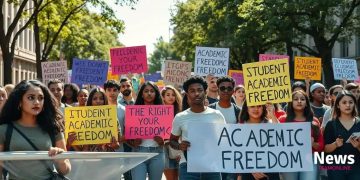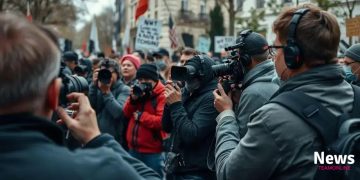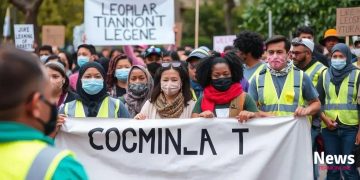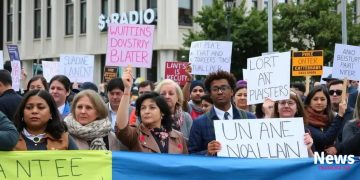Protest crowd management policies: navigating challenges effectively

Effective protest crowd management policies involve strategic planning, clear communication, leveraging technology, and learning from past protests to create a safe and respectful environment for all participants.
Protest crowd management policies play a vital role in ensuring safety and order during demonstrations. Have you ever wondered how authorities balance freedom of expression with public safety? Let’s delve into effective strategies and insights.
Understanding the importance of crowd management
Understanding the importance of crowd management during protests is crucial for maintaining order and safety. When large groups gather, tensions can rise quickly, making effective management techniques essential.
Why Crowd Management Matters
Effective crowd management helps minimize chaos and ensures everyone’s safety. By managing crowds, authorities can address potential risks while allowing peaceful protests to occur.
- Prevents violence and disorder
- Ensures public safety
- Maintains freedom of expression
Authorities must anticipate issues that could arise during protests, such as overcrowding or potential confrontations. By preparing in advance, officials can deploy strategies that keep events peaceful and organized.
Key Benefits of Crowd Management
Implementing strong crowd management policies offers numerous benefits. These include the proper routing of crowds, the prevention of harmful situations, and the enhancement of the protest experience for participants. When well-managed, crowds can express their views without fear.
- Improves communication between law enforcement and protesters
- Fosters a secure environment for everyone
- Allows for a positive public image of protest movements
Through proper management, engagements between authorities and protesters can occur positively, focusing on dialogue rather than confrontation. By understanding the importance of crowd management, communities can support peaceful resistance while safeguarding their rights.
Key strategies for effective protest management
To ensure peace during protests, employing key strategies for effective protest management is vital. These strategies can help foster understanding between authorities and demonstrators.
Planning and Preparation
Thorough planning is essential for successful protest management. Agencies need to assess potential risks and map out effective response plans. This includes understanding the expected crowd size, the location, and the nature of the protest.
- Conducting risk assessments
- Developing clear communication plans
- Allocating the right resources
Preparation allows for flexibility and quick adjustments during the event. It is important to be ready for unexpected situations, which can help maintain order and safety.
Effective Communication
Clear communication is another crucial strategy. Law enforcement and protest organizers should establish open dialogues. Sharing information on both sides helps build trust.
- Using social media to inform the public
- Providing clear instructions to attendees
- Ensuring officers are approachable
When protesters feel heard and understood, they are more likely to cooperate and return to peaceful behavior quickly.
Furthermore, officers assigned to manage crowds should be trained in de-escalation techniques. This is important for maintaining calm during heated moments. Recognizing signs of mounting tension can help avoid conflicts before they escalate.
Ultimately, understanding and implementing these key strategies for effective protest management can lead to improved outcomes. By focusing on preparation and communication, authorities can ensure that protests remain peaceful and productive for all parties involved.
Technology’s role in crowd control
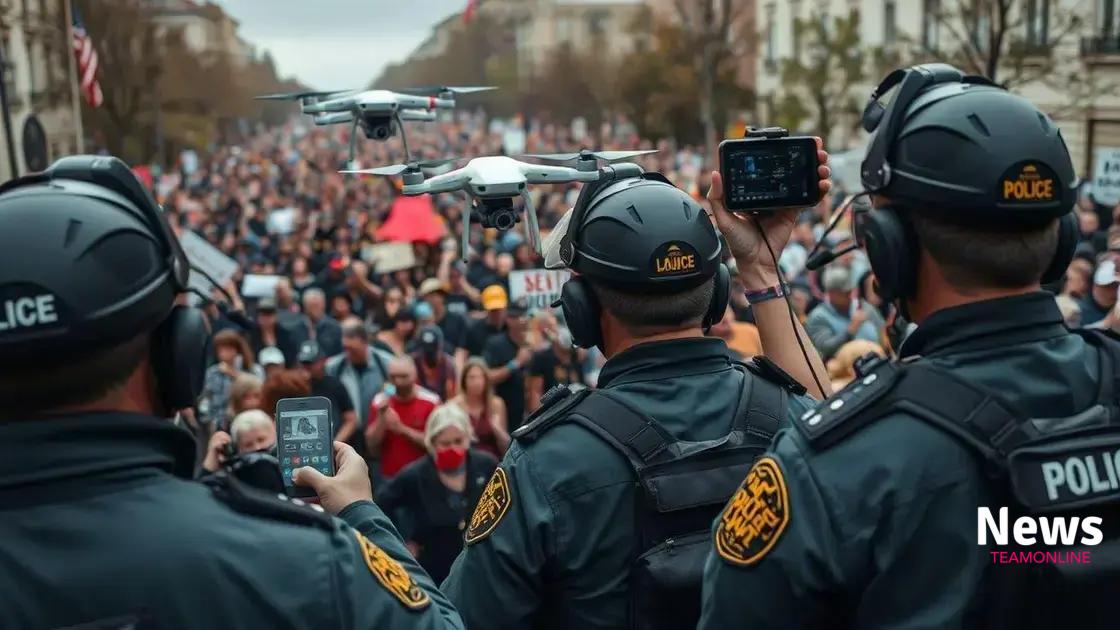
Technology plays a significant role in enhancing crowd control during protests. By using modern tools, authorities can effectively monitor and manage large gatherings.
Surveillance and Monitoring
One major aspect of technology in crowd control is surveillance. Drones and cameras can provide real-time footage of events, allowing for quick assessments of situations. This helps authorities act promptly and efficiently.
- Real-time video feeds
- Facial recognition for identifying individuals
- Data analysis to predict crowd behavior
With these tools, it’s easier to identify potential issues before they escalate, leading to a safer environment for everyone involved.
Communication Tools
Effective communication is essential during protests. Advanced communication systems allow officers to share information quickly. This can help coordinate responses and direct resources where they are most needed.
- Mobile apps for instant messages
- Push notifications to keep the public informed
- Radio systems for seamless communication among officers
By using these technologies, authorities can maintain a clear line of communication that enhances safety and reduces misunderstandings.
Additionally, social media platforms can influence crowd dynamics. Protest organizers can use these tools to spread messages quickly, enabling better organization. However, authorities can also monitor social media to gauge public sentiment and detect potential disruptions in advance.
The integration of technology into crowd control strategies provides numerous benefits to managing protests. It allows for better planning, response, and communication, ultimately leading to a safer environment for all participants.
Challenges faced by law enforcement in protests
Law enforcement faces many challenges during protests, making their roles complex and demanding. Understanding these challenges faced by law enforcement in protests can help improve strategies and responses.
Public Expectations
One major challenge is meeting public expectations. People expect police to maintain order while also respecting their right to protest. Striking the right balance is difficult, particularly when tensions run high.
- Pressure to maintain peace
- Need to respect freedom of speech
- Managing public perception
When law enforcement fails to meet these expectations, it can lead to misunderstandings and conflicts between officers and protesters.
Communication Difficulties
Effective communication is crucial but often challenges arise. Misinterpretations during protests can lead to escalated tension. Officers must relay instructions clearly, while also listening to the concerns of protesters.
- Adapting to different group dynamics
- Using clear and non-threatening language
- Engaging with community leaders
Improving communication strategies can help build trust and reduce the chances of conflict.
Additionally, technological limitations can hinder their ability to monitor crowds effectively. Without proper tools, law enforcement may struggle to assess the situation, leaving them vulnerable to potential outbreaks of violence.
The environment itself also presents challenges. Crowded spaces can make it hard for officers to maneuver or provide assistance when needed. Managing large crowds requires planning and coordination, which isn’t always possible in rapidly changing situations.
Being aware of the challenges faced by law enforcement in protests can lead to better preparation. By developing understanding and strategies, authorities can enhance safety for everyone while respecting the rights of individuals to express their views.
Lessons learned from past protests
Evaluating the lessons learned from past protests is crucial for developing effective crowd management policies. Analyzing previous events can reveal what strategies worked and what did not.
Understanding Diverse Perspectives
One significant lesson is the importance of acknowledging the diverse perspectives within a protest. Different groups may have varying goals and messages, leading to differing approaches to crowd management. Recognizing this diversity helps authorities navigate complex situations more effectively.
- Engaging with community leaders
- Listening to protesters’ needs
- Being adaptable to different group dynamics
This understanding can create a more peaceful environment and enhance cooperation between law enforcement and protesters.
Effective Communication Strategies
Clear communication has proven essential in past protests. When law enforcement communicates openly, it reduces misunderstandings and builds trust. Establishing proper communication channels allows crowds to hear necessary instructions and alleviates fears of mishandling the situation.
- Using social media for updates
- Employing community liaison officers
- Providing clear directions in real-time
Learning from instances where communication broke down highlights the necessity for clarity and consistency in messaging.
Another vital lesson is that preparedness can make a significant difference. Protests can quickly escalate, and being well-prepared with resources and plans helps manage unexpected situations. Past events show that flexibility and quick decision-making are essential in maintaining peace.
By analyzing the lessons learned from past protests, law enforcement can enhance their strategies for future events. Each protest offers learning opportunities that can lead to better responses, fostering a safer environment for all involved.
FAQ – Frequently Asked Questions about Protest Crowd Management
What are the key strategies for effective protest management?
Key strategies include planning and preparation, effective communication, and understanding the diverse perspectives of protest participants.
How does technology aid in crowd control during protests?
Technology, such as drones and communication apps, enhances monitoring, improves communication, and helps in assessing crowd dynamics.
What challenges do law enforcement face during protests?
Challenges include meeting public expectations, communication difficulties, and managing diverse crowd dynamics in rapidly changing situations.
How can lessons from past protests improve future strategies?
Learning from past experiences allows authorities to develop better communication strategies and improve preparation for managing complex protest scenarios.
